| . |
| . |
| . |
| . |
| . |
| . |
| Peter's Logger
Page
. . |
|
The logger project is in the moment 'on hold'. Not that I wouldn't want to finish it, there are also no technical problems. The reason is simply, that I'm working on another large project for a customer which took longer than originally planned and it's still going on. I just had to set up priorities, and since the logger is 'my own' thing without a real 'deadline', my customer got the first priority. . I already invested a considerable amount of time and money in the logger, so I won't let it down for sure. I will finish it, I just don't know exactly when. If you're interested, please check that page from time to time, or write me a short email to be notified by email when the logger is released. . Let me say again how sorry I am about the current situation, I hate early announcements myself. I hate to discover cool stuff, then you can't buy it for ages. But I just couldn't forsee the development of things ... my appologies! . |
| . |
| . |
| . |
| . |
| . |
| . |
|
Well, from the first day on I saw a Pilot, I wanted to create any nice hardware add-on for it. But for some strange reasons I started with shareware first (basically not my 'roots') and it took me until now, to finally realize my original plan. . *** Here it is: The Pilot Logger *** . |
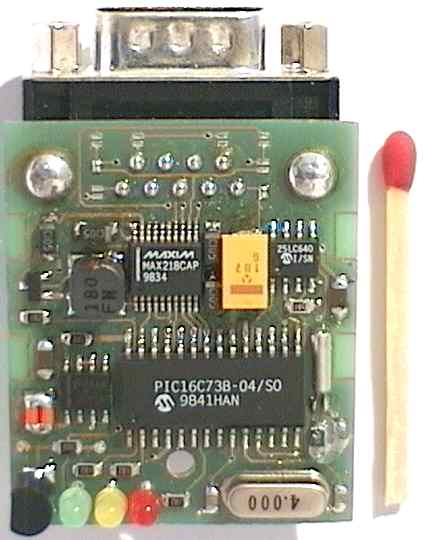 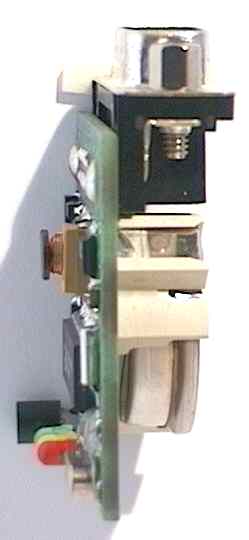 |
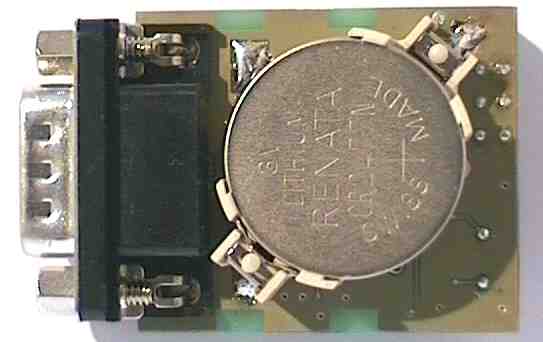 |
| General description
. The device you see above is a tiny temperature logger, that is able to record automatically up to 4000 temperature meassurements. Well you might say, I saw these devices before - what's new? Easy! Since I call it Pilot Logger it's optimized to be setup and retrieved with any 3Com palm-sized device. You can control all functions of the logger i.e. directly in the field, no need for a PC or notebook. See the screen shots below ... . |
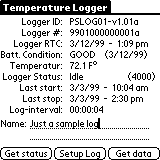 .... ....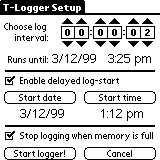 .... ....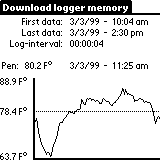 .... .... |
| .
The logger comes with its own real-time clock and works completely independent up to 5 years with a single Lithium button cell. Once set, it logs the temperature with the set intervall. This intervall can vary between 2 seconds and 24 hours. That gives a total recording time between ~ 2 1/4 hours up to ~ 10 years (theoretically, if supplied with a longer lasting power source). All values are stored in non-volatile memory, so even if the power supply should fail, the values logged so far are always safe. The unit can be setup to stop the log when the memory is full or to log endless, overwriting always the oldest values. In that mode it can be perfectly used as a 'history' device. Additionally a delayed log start anytime in the future can be set up (yes, the logger firmware is year 2000 compliant <g>). The data is offloaded via a true RS-232 port that works with 19200 baud, the download of all 4000 values doesn't take longer than 10 seconds. The data can be stored and viewed on the receiving device. Since the Pilot has a very limited graphic capabilty and resolution, the logger comes also with a PC application (Win95/98). See the screenshot below ... . |
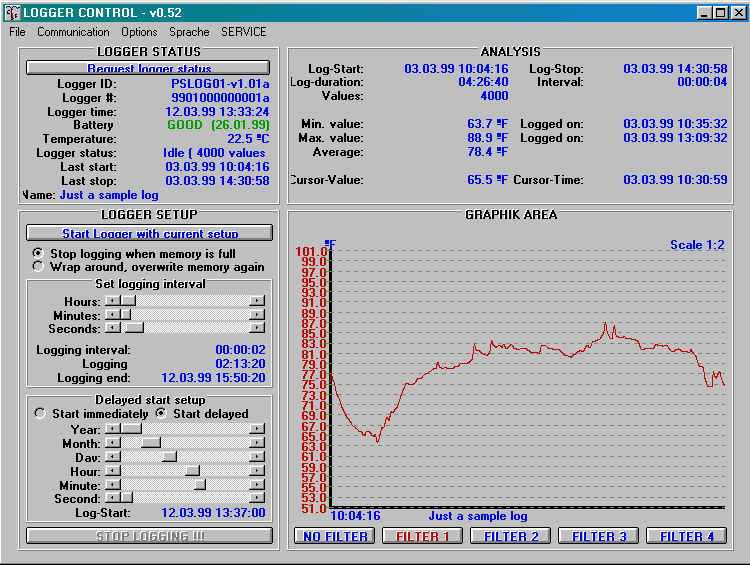 |
| Software details
. Both apps - the Pilot and the PC version - support to retrieve the logger status anytime. It informs about every interesting detail about the connected device:
. The software draws a graph of the recorded temperature curve and you can easily point on the graph to find out the time/date and exact temperature for any peak or point you're interested in (yep, that works also on the Pilot ... just tap on the point of interest with the stylus). There is a minimum, maximum and average temperature readout and the time/date for these extremes. The data can also be exported in various common formats to be used in spread sheet applications. Needless to say, the software supports Celcius as well as Fahrenheit and you can convert all values between units anytime. You can display up to 4 addtional data sets to compare. If possible, the data sets are 'time aligned' automatically, so you can compare the temperature of different locations at exactly the same time, without the need to start the logs exactly at the same time - the software syncronizes automatically the data points that belong together (using more than one logger). . New logger tasks are setup completely in an easy to operate GUI. Just choose a log interval - you get an instant calculation of the duration of the log and the estimated end, choose whether the log should start immediately or delayed (and an eventual start time), select whether the memory should be just filled or wraped-around and start the logger. Then you can disconnect the unit and put it in the place you want to record the temperature. Together with the Pilot app, the logger could also be fixed installed anywhere and you 'walk by' with the Pilot to retrieve any pending values. At home you just hotsync and process the data then. . |
Hardware details
|
| Nice, but what should I do with it?
. After reading all the facts, you might wonder what you can actually do with a logger ... well, let me tell you how I came to it. Actually I bought my first temperature logger already a few years ago just for fun - don't we all love nice 'toys'? But with the possibility to put that little thing in any 'closed' system - where you normally can hardly fit a cable, not to talk about 'watching' a thermometer all the time - more and more applications came to my mind:
. |
| Availabiliy, price and an amazing hotsync adapter
. As you can see by the images and the screen shots, the logger is definitely no 'vaporware'! Most of the development is finished and the final tests are running quite successfullly. But it's not yet available right now. I still have to find the right case for it and - the worst part <g> - I have still to do all the documentation. Another reason is, that I'm still not sure what options I should offer. For sure it would be nice to have a completely water-proof, dust- and dirtproof case. But that would make the whole thing much more expensive. Can I offer it as a 'naked' device and the user will take care of the case he wants himself? That are all questions I have to clear still. . Thanks to my friend Dan Royea who had that idea, I found at least a nice solution to connect the logger with the Pilot. For a matchbox sized unit, a clumsy cable seemed so inappropriate. . |
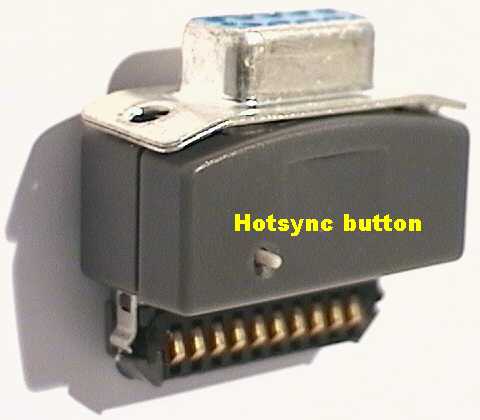 |
| .
What you see above is the smallest adapter 9-pin SUB-D to Pilot. Since it would have been a waste to connect just the 3 needed wires for the logger, I connected all needed wires for a complete hotsync connection and since there was plenty of space left <g>, I fitted also a tiny hotsync switch - so above you see the most likely smallest hotsync adapter for the Pilot. Yes it works, especially with a notebook it's not so bad to plug in the Pilot directly in the back of the notebook ... and with the tiny hotsync button you don't even have to search the hotsync app :). And no, you can't buy that anywhere .. it's a prototype I did for *any* company that wants to produce it ... I'd be their first customer :). If there are no takers, I'll do it myself. . The price of the logger is also not yet fixed, it depends too much on the facts I mentioned above. A good case can cost as much as the whole electronics, not to talk about water-proof connectors. But I definitely wanted to keep the price on 'gadget' level :). As far as I have it calculated now, I could sell the 'naked' unit, completely calibrated with all the software between $70-$80. That's quite acceptable, after all 0.1ºC resultion with an absolute accuracy of 0.2ºC requires some quite precise parts as well as an individual calibration of each unit. . My current plan is to have all that cleared by end of April and the first units should be available latest in May 99 ... so if I waked your curiousity, please check back here from time to time, I will post any updates on that page. . |
| Future plans and devices
. I know, I should launch the first logger before thinking about the next generation. But I would be a lousy developer, if I didn't plan for the future. The whole hard- and firmware is already concepted for other environmental meassurements. There is humidity, light, UV-light (good for sun bathing), wind speed, amount of rain, distances, acceleration etc. etc. It's basically just a matter of the right sensors. I see the temperature logger just as the first of a whole 'family'. But you're right ... I should start shipping that one first :) ... . . |
|
Last updated: August 31th, 1999 Copyright © 1999-2000 by Peter Strobel, all rights reserved. |